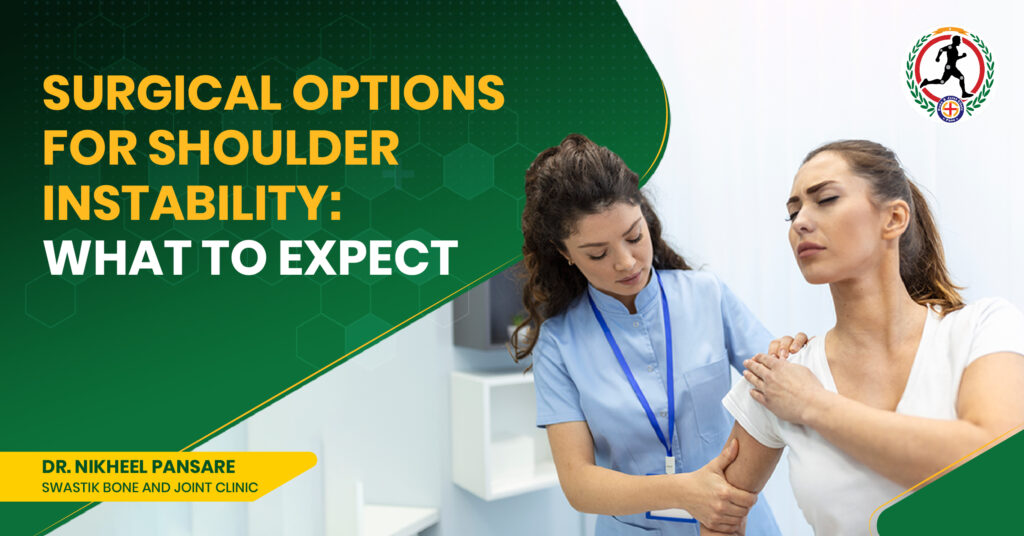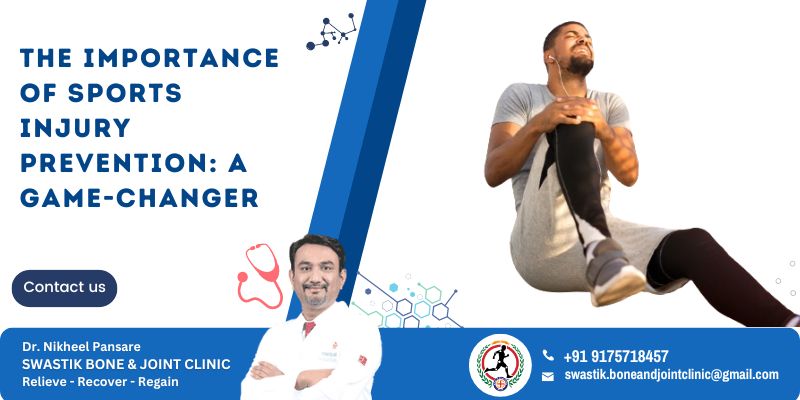Shoulder instability is a common condition that arises when the shoulder joint becomes too loose, causing it to slide or dislocate frequently. This condition can result from traumatic injuries, such as falls or sports-related accidents. It often leads to significant discomfort and limited mobility because of fear of dislocation, negatively affecting your quality of life. While non-surgical treatments like physical therapy and medication are typically the first line of defense, surgery may become necessary if these methods fail to provide relief.
At Swastik Bone & Joint Clinic, under the expertise of Dr. Nikheel Pansare, the best orthopedic doctor in Kharadi & East Pune, patients receive advanced treatment options for shoulder instability. In this Blog, we will explore the surgical solutions available for shoulder instability, what to expect from the procedure, recovery tips, and how to return to regular activities. If you are searching for the best orthopedic doctor in Kharadi and East Pune, Dr. Nikheel Pansare is here to help you regain your mobility and quality of life.
Understanding Shoulder Instability
The shoulder joint is one of the most mobile joints in the body, allowing a wide range of motion. However, this mobility also makes the shoulder more prone to instability. Shoulder instability occurs when the structures that hold the shoulder in place (such as the labrum and congruent bony surfaces) are unable to keep the ball of the upper arm bone (humerus) securely in the socket of the shoulder blade (glenoid).
There are two types of shoulder instability:
- Traumatic shoulder instability – typically caused by a sudden injury, like a fall or collision, resulting in dislocation or subluxation (partial dislocation).
- Atraumatic shoulder instability – often the result of repetitive motions (common in athletes like swimmers, gymnasts, or pitchers) causing the shoulder to become loose especially in individuals with natural ligament laxity.
When is Surgery Necessary?
Surgery for shoulder instability is generally considered in repeated dislocations and when non-surgical treatments, including physical therapy and medications, fail to stabilize the shoulder or relieve symptoms. Some common reasons for opting for surgery include:
- Recurrent dislocations or subluxations
- Significant damage to the labrum, Humerus Head and Glenoid (socket) bony surface
- An unstable shoulder that doesn’t improve with rehabilitation
The decision to undergo surgery is based on the severity of the instability, the patient’s age, activity level, and overall health.
Surgical Options for Shoulder Instability
Several surgical procedures can address shoulder instability. The choice of surgery depends on the cause and extent of the instability, the condition of the shoulder joint, and the patient’s specific needs.
1. Bankart Repair
A Bankart lesion occurs when the labrum (a ring of cartilage that helps stabilize the shoulder) tears away from the socket following a dislocation. This is common in younger patients and athletes.
Bankart repair involves reattaching the torn labrum to the shoulder socket using sutures or anchors. The procedure is performed arthroscopically (minimally invasive keyhole surgery). Arthroscopic Bankart repair is generally preferred due to smaller incisions, less scarring, and quicker recovery times.
What to Expect: After surgery, you’ll wear a sling for a few weeks to immobilize the shoulder. Physical therapy is essential to regain motion and strength, with a gradual return to sports or activities after about 4-6 months.
2. Latarjet Procedure
The Latarjet procedure is often recommended for patients with bone loss in the glenoid socket or failed Bankart’s repair. During this procedure, a portion of the coracoid bone (a small bone near the shoulder) is transferred to the front of the shoulder socket to increase its stability. This bony block provides increased contact surface and acts as a barrier to prevent the humerus from sliding out of the socket.
What to Expect: The Latarjet procedure is highly effective for patients with significant bone loss or chronic instability. However, it requires a longer recovery time, with return to full sports or high-demand activities taking around 6-9 months.
3. Remplissage Procedure
The Remplissage procedure is often performed alongside a Bankart repair in patients who have a Hill-Sachs lesion (a bone defect on the humeral head). This procedure involves filling the defect by attaching the posterior capsular soft tissue to the damaged area, preventing the humeral head from engaging with the shoulder socket.
What to Expect: Since this procedure is usually combined with a Bankart repair, recovery follows a similar path, with most patients returning to sports after 4-6 months.
5. Rotator Cuff Repair
In some cases of shoulder instability, especially in older patients or those with chronic conditions, the rotator cuff—the group of muscles and tendons that stabilize the shoulder—may also be damaged. Surgical repair of the rotator cuff can be combined with other procedures to restore shoulder stability.
What to Expect: Recovery from rotator cuff repair takes longer, with full recovery taking up to a year depending on the severity of the tear and the patient’s adherence to rehabilitation protocols.
What to Expect After Surgery
After shoulder surgery, the initial phase of recovery involves protecting the repaired structures while controlling pain and swelling. This is followed by a rehabilitation program designed to restore motion, strength, and function to the shoulder.
Here’s a general timeline of what to expect post-surgery:
Week 1-6: Immobilization and Gentle Motion
- You’ll likely wear a sling for 3-6 weeks, depending on the type of surgery.
- Gentle passive exercises may be started under the guidance of a physical therapist to maintain range of motion without stressing the repair.
Week 6-12: Active Motion and Strengthening
- The focus shifts to an active range of motion exercises and light strengthening exercises.
- You may be able to perform some daily activities like dressing depending on your progress.
Week 12-24: Full Recovery and Return to Activity
- Rehabilitation becomes more aggressive, with a focus on restoring full shoulder strength and endurance.
- Most patients can return to light work and non-contact sports by 3-4 months, while more demanding activities like contact sports may require 6-12 months.
Conclusion: Take the Next Step Toward a Stable Shoulder
Surgical options for shoulder instability are varied, with each procedure tailored to address specific types of instability and individual patient needs. Whether it’s a Bankart repair, Latarjet procedure, or Remplissage, these surgeries offer a path to regain shoulder stability, alleviate pain, and return to an active lifestyle.
If you’re struggling with recurrent shoulder dislocations or chronic instability, don’t hesitate to seek professional advice. At Swastik Bone & Joint Clinic, renowned orthopedic doctor in Kharadi and East Pune. Dr. Nikheel Pansare offers personalized treatment plans, including advanced surgical options to address shoulder instability and other joint issues. With extensive experience in shoulder surgeries, Dr. Pansare is dedicated to helping you achieve optimal recovery and a pain-free life.
To learn more about your surgical options or to book a consultation, contact Swastik Bone & Joint Clinic today and take the first step towards a more stable and functional shoulder. Remember, when searching for the best orthopedic doctor in Kharadi & East Pune, your health is in expert hands.










